TC
Auto Added by WPeMatico
Auto Added by WPeMatico
Nylas, a startup that helps developers integrate email content into applications via an API, announced a $16 million Series B today led by Spark Capital.
Other investors joining in included Slack Fund, Industry Ventures, and ScaleUp along with existing investors 8VC, Great Oaks Capital, Rubicon Venture Capital and John Chambers’ personal fund. Today’s investment brings the total raised to $30 million.
The Nylas API works in a similar way to Stripe or Twilio, but instead of helping developers connect to payments or communications with a couple of lines of code, Nylas helps them connect to email, calendar and contact information. The idea behind any API like this is to give developers who lack expertise in a particular area outside the core purpose of their application, easy access to a particular type of functionality.
Company CEO Gleb Polyakov says that prior to Nylas, there really wasn’t an effective way to connect to email systems without a lot of technical wrangling. “Every person who is using the Internet has an email address, and there’s an immense amount of data that lives in the mail box, in the calendar, in your address book. And up until now, companies have been unable to effectively use that data,” he told TechCrunch.
It seems like a must-have kind of ability to connect to this type of information from any application, but most companies have shied away from a comprehensive approach because it’s hard to do, says company co-founder and CTO Christine Spang.
“We have essentially built adapters for the native protocols for each email system: Gmail, Microsoft Exchange, open source IMap servers and all the different extensions that are available on the different IMap implementations. And the key part is that with these adapters, we can talk to backend providers like Google, GoDaddy and Yahoo, Spang explained.
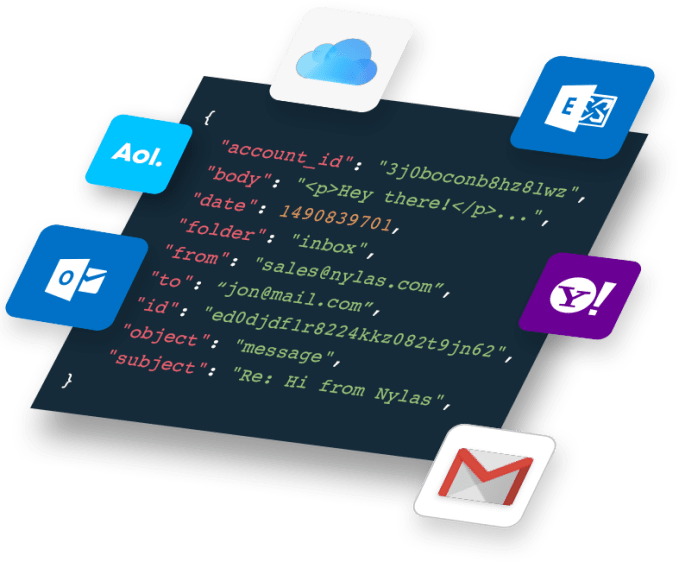
Photo: Nylas
This capability could be useful for developers in lots of scenarios such as pulling data for a CRM tool from an email exchange between a salesperson and a customer, or to coordinate meetings around the calendars of several individuals and an open meeting room that works for all of their schedules.
The company, which has been around for five years, currently has 35 employees with offices in New York and San Francisco. With the new funding, they expect to double that number by the end of the year, as it adds engineering and builds out its sales and marketing team. While much of the marketing up to now has been inbound from developers, they want to expand their customer base by marketing directly to companies.
It currently counts 200 customers and thousands of developers using the product. Customers include Comcast, Hyundai, News Corp, Salesloft and Dialpad.
Powered by WPeMatico
When you’re working in a key business tool like Slack or Salesforce, you don’t want to switch focus by opening up another application to pull additional information. Evernote Business has let you access Evernote content from these applications for some time, and today it announced some refinements to enhance those integrations.
The Slack integration had worked with the old slash commands to display Evernote content directly within Slack, but Slack has changed that to allow you to access applications like Evernote in a more visual way, says Erik Wrobel, chief product officer at Evernote.
“Earlier this year, Slack announced something called Slack Actions. It allows you to surface an application in a more visual way, so discoverability and ease of use is better to reduce friction,” he said.
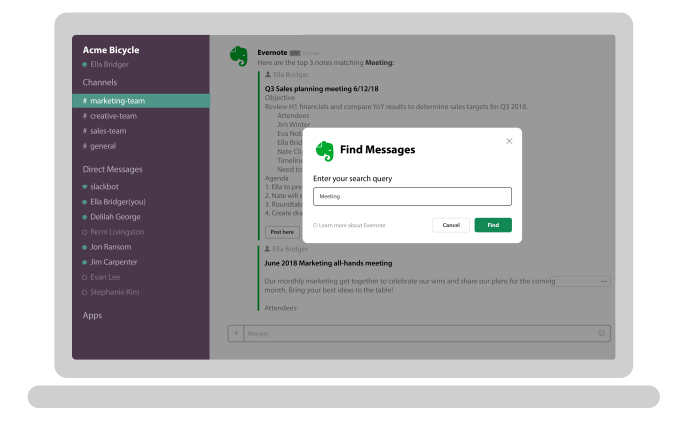
Evernote embedded inside Slack. Screenshot: Evernote
Evernote has take advantage of this new capability in this release to get away from the command interface style that Slack had previously used and make it easier for their core knowledge workers to access Evernote content inside of Slack.
Users can take an Evernote note in Slack, which will then show up in Evernote automatically in a “Notes from Slack” folder. From there, users can edit the notes and move them to other folders (or tag them) to further organize them in any way they see fit. Similarly you can save a conversation you’re having in Slack to Evernote as a note and move it or edit from Evernote later on.
While Salesforce deals with structured systems of record, Evernote works with unstructured content and bringing the two together can be useful and powerful for users. Typically, a team member interacting with the customer on the phone or in the field, will take notes in Evernote, and they want to share that information with other members of the team in the Salesforce record, Wrobel explained.
The user who took the note can link one or more notes inside Salesforce, so they essentially become part of the customer record. The newer version improves the technical connections between the two cloud applications including the ability to “pin” a note to a record. What’s more, once a note is linked there is two-way sync, which means regardless of whether you change that note in Salesforce or Evernote, it will update in both places (because the integration is a live version of Evernote).
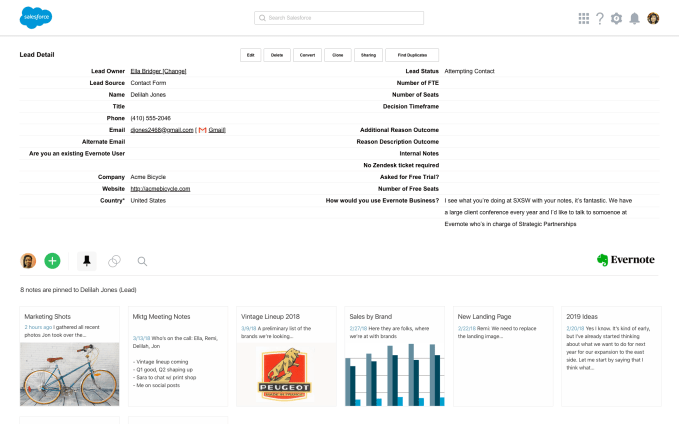
Evernote notes embedded in Salesforce record. Screenshot: Evernote
Evernote also surfaces related content automatically at the bottom of the customer record to help users find other Evernote subject matter connected to the record. While you can’t link a note to Salesforce directly from Evernote yet, that is a requested feature and Wrobel said they are working on it for a future release.
These updates are available today for Slack and Salesforce customers using Evernote Business.
Powered by WPeMatico
From yeast-grown cannabinoids to project management software to consumer apps looking to gauge opinions on college campuses, a wide variety of spaces was represented on the second day of pitches from Y Combinator’s Summer 2018 class.
As we noted yesterday, B2B software and services was the biggest vertical with 30 percent of the 132 startups falling into that slice of the categorical pie. Healthcare-related startups were close behind with 28 percent. Here’s the full breakdown if you’re curious.
Aerospace: 3%
Agriculture: 1%
Automotive: 2%
B2B Software and Services: 30%
Blockchain: 5%
Consumer Goods and Services: 9%
Consumer Media: 7%
Education: 3%
Fintech: 6%
Government: 1%
Healthcare: 28%
Industrial: 1%
Real Estate and Construction: 4%
Below is an exhaustive look at the group of 59 startups that presented today. We swear you’ll feel like you were actually there at the Computer History Museum watching the presentations alongside us. Also, if you’re thirsty for more of the latest picks from one of Silicon Valley’s premiere accelerators check out our list from Day 1.

Mental Happy is an employee gifting service that assembles what it calls a Cheerbox. Taking sham expressions of care for laboring office drones to the next level, Mental Happy throws out the flowers and ditches the dumb office knickknacks in favor of positive messaging and things they reckon employees can actually use, including food, wellness gifts, and personalized notes. The average price for one of these bundles of joy? $59 on average. Some people are buying, too. The young company says it has already generated $50,000 in sales over the last two months.

With a service that already holds $10 million in assets from thousands of clients, Titan is setting itself up to stand above other consumer-facing fintech offerings. The company is an asset manager that’s building, managing, and explaining its investment theses for normal investors. The company takes its customers through their portfolio using in-app video and other illustrative tools to make understanding strategies easier — and investing with the company more transparent.

The cost of childcare is one of the biggest financial burdens American families face, and though there’s up to $30 billion in government money available for childcare in the U.S. each year, it’s locked up in flexible spending accounts that are so complicated that 90 percent of that funding goes unused.
Kinside wants to help by automating the claims process. It also serves as a childcare management tool, letting parents pay their care providers with a Venmo-like feature, while making it simpler for companies to offer childcare benefits that can help attract talented employees. The company, which launched just six weeks ago, says it plans to target employers with more than 20 employees, which is a big market. There are more than 620,000 such businesses in the U.S. As for the total addressable market Kinside sees itself chasing, it’s $2.8 billion.

Travel and experience marketplace Fixers pitches experiences ranging from yoga retreats to trail running weekends and music festivals that are curated by the locals in-the-know. It’s designed to help travelers discover and book trips they couldn’t find anywhere else. The company has seen $1.7 million in sales in 8 months, with 7,000 activities booked, and the company hasn’t spent a dollar on marketing. The founders assert that millennial travelers are primarily motivated by experiences, rather than destinations. Entrepreneurs like yoga teachers are running businesses and retreats and making money on Fixers.

With a founding team including some of the leading luminaries in the field of biologically inspired engineering (including George Church, Pamela Silver, and Jeffrey Way from Harvard’s Wyss Institute) 64-x is engineering organisms to function in otherwise inaccessible environments. Chief executive Alexis Rovner, herself a post-doctoral fellow at the Wyss Institute, and chief operating officer Ryan Gallagher, a former BCG Consultant, are looking to commercialize research from the Institute around accelerating and expanding the ability to produce functionalized proteins and sequence-defined polymers with diverse chemistries.

Papa’s slogan is “grandkids on demand.” To solve the problem of loneliness, Papa connects college students with senior citizen homes. College students are matched with seniors to help them with tasks related to transportation and technology, but mainly the goal is to provide companionship for people who are at risk of loneliness. The founders assert that loneliness puts the country’s more than 50 million seniors at risk for health problems like Alzheimer’s; indeed, Medicare covers Papa through a UPMC health plan because of the more widely accepted belief that socializing well into one’s golden years is a critical component to living a healthier life.

Unhappy employees cost money, but Tall Poppy thinks it can keep more of them in place by providing an educational toolkit to those who are being harassed, a kit that teaches them how to lock down their online presence and manage incident response properly.
The brainchild of Leigh Honeywell, a security specialist, the startup grows out of the work that Honeywell has been doing to hunt down trolls in online communities since 2008, including at Slack, where she protected colleagues who’d been targeted by outsiders by starting, first, with strengthening their otherwise vulnerable personal accounts, then targeting sites where bad actors congregate.
Tall Poppy not only works with customers to educate them how to protect themselves but also to make them aware of the laws in each state that they can use to protect themselves and punish their attackers. Meanwhile, for $150 a seat per year, its software is comparable to other risk management tools.
Read more about Tall Poppy here.

AnchorUSD is a stable cryptocurrency backed one-for-one by the US dollar. The founding team wants to be the trusted reserve currency of the crypto financial system. They are aiming to develop a service that will provide the most trusted, stable storage of value on the blockchain.
Tether is not trusted, but since there’s no other option it has become the medium of exchange. Anchor wants to replace Tether. It’s built on Stellar and has become the official partner of Stellar, which means they’re cheaper, faster and safer. Transaction costs plus interest on float. The founder claims to have solved Stripe’s scaling problems and the other worked on growth at Facebook.

Ixora’s technology wants to do nothing more than enable the creation of photorealistic environments for any kind of visual entertainment, and it says it can do this a heck of a lot more cheaply than big studios.
According to Ixora, major film studios produce 100 blockbuster films each year that feature than 1,000 CGI shots — each costing them roughly $10,000 a pop. Its software can do the same for next to nothing, Ixora says, and it can do it within “hours.” If that pitch isn’t compelling enough, consider beyond movies that TVs, games, and VR experiences are all beginning to require movie-level graphics. With rich photorealistic environments becoming the norm across the entertainment industry (witness “Game of Thrones” and “The Jungle Book” as just two examples), Ixora could be catering to a sizable market for a long time to come.

Image: Bryce Durbin/TechCrunch
Collecting and identifying photo identification becomes a breeze with Berbix, a company that’s aiming to make what amounts to Stripe for identity verification. The company has developed an integration with its software so that companies can cut costs and deter fraud. Founded by two former product and engineering leaders for trust and safety at Airbnb, they’re trying to build identity verification for all kinds of peer-to-peer marketplaces and online platforms, which they see as a $10 billion opportunity (at least).
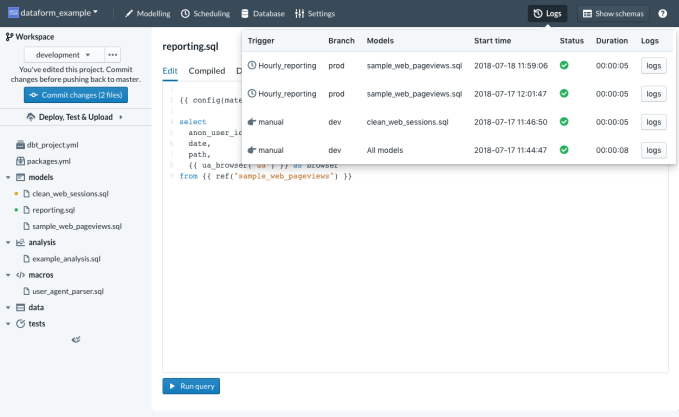
Dataform is building software to help the data teams that spend 80% of their time preparing and formatting the data they need to conduct analyses, create dashboards or perform machine learning functions. The company has built toolkits that help collect and manage that data so it can be used (This post was updated to clarify Dataform’s business and url).

Sher Butt, a former lab directory at Steep Hill, saw that cannabinoids were as close to a miracle cure for pain, epilepsy and other chronic conditions as medicine was going to get. But plant-based cannabinoids were costly and produced inconsistent results. Alongside Jacob Vogan, Butt realized that biosynthesizing cannabinoids would reduce production costs by a factor of ten and boost production 24 times current yields. With a deep experience commercializing drugs for Novartis and as the founder of the cannabis testing company, SB Labs, Butt and his technical co-founder are uniquely positioned to bring this new therapy to market.
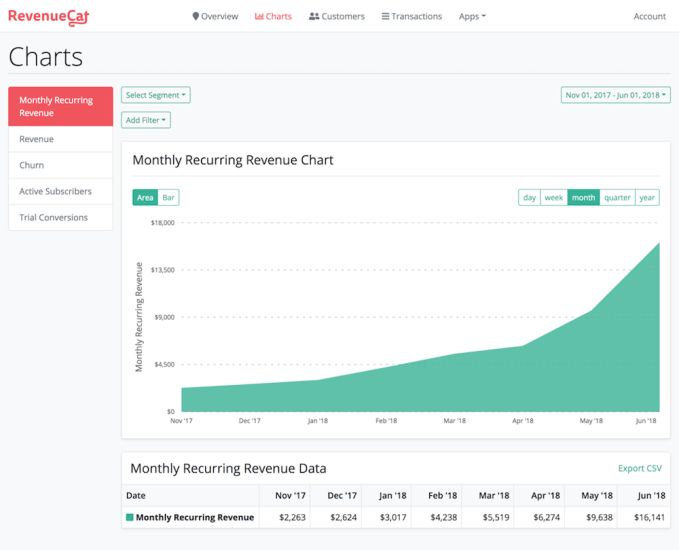
RevenueCat helps developers manage their in-app subscriptions. It offers an API that developers can use to support in-app subscriptions on iOS and Android, which means they don’t have to worry about all the nuances, bugs and updates on each platform.
The API also allows developers to bring all the data about their subscription business together in one place. It might be on to something, though it isn’t clear how big that something is quite yet. The nine-month-old company says it’s currently seeing $350,000 in transaction volume every month; it’s making some undisclosed percentage of money off that amount.
Read more about RevenueCat here.

Photographer: Andrew Harrer/Bloomberg via Getty Images
HeyDoctor is the online prescription service for a growing of startups and services that are pitching medications and prescriptions online. Working with these companies, HeyDoctor can prescribe and refill prescriptions for medicines ranging from birth control, hair growth or replacement, urinary tract infection treatments, lab work and much more.
The company envisions creating an alternative medical record platform that’s open and accessible to patients and portable among on-demand providers. Already, more than 125,000 primary care visits have been conducted on the platform in the last 6 months. Last month, it made $105,000 in revenue, and it says that number reflects 22 percent growth month over month.
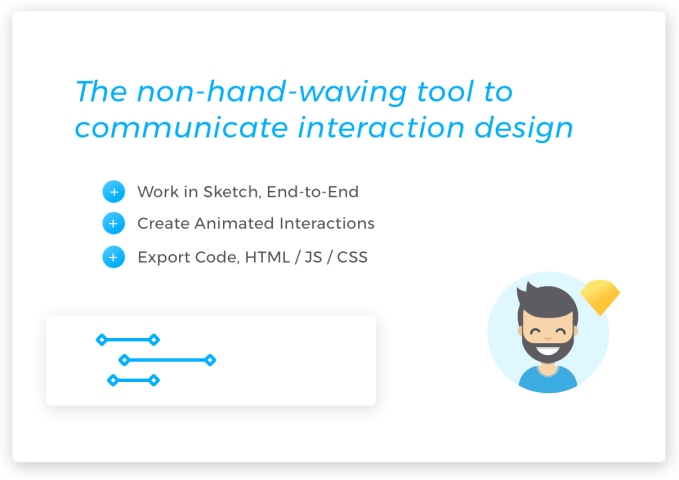
Or Arbel, the former chief executive and cofounder of YO, is back with a new company that’s a bit more sophisticated in its goals and complicated in its execution. Arbel is one of the co-founders of the new Y Combinator-backed startup Anima, which allows designers to convert design to code, automatically.
Using the tool, Arbel and his team — individuals who are culled from the engineering and design ranks of Google, Apple, and Amazon –estimate that development teams can save weeks of work, eliminating crosstalk between designers and developers. It has some early believers, too. According to Arbel, Netflix, Google, and Amazon are already using its tools, for which it plans to charge $500 per seat per year.

Influencers of the world are uniting on mobile app, ShopWith, which allows shoppers to browse virtual storefronts and aisles alongside their favorite fashion and beauty creators and YouTubers. Users can see exactly what products those influencers have featured and can buy them without ever leaving the app. It’s a free download and hours of commercially consumptive fun.
It’s like the QVC model, but for GenZ shoppers whose buying habits are influenced by social video content on YouTube, Instagram and Snapchat. The company revealed that one beauty influencer made $10,000 within five hours, using the ShopWith platform. The founders are former product managers with experience building social commerce products at Facebook and Amazon.

ZiffyHomes is bringing the co-living model popularized in the U.S. to millennials in India. With a clutch of managed, co-living, furnished apartments already in its portfolio, ZiffyHomes is already serving more than 2,000 young Indian professionals and seeing $2.2 million in annual revenue from the three Indian cities in which it operates. But it has ambitions to cater to up to 60 million more people across the country who fit into its target demographic, and given that it takes 20 percent of the rent paid, you can see how its revenue could grow quickly.
The company has competition, of course. It compares itself to WeWork, yet WeWork itself is making major inroads in India. Another, smaller competitor, a Mumbai-headquartered startup called Awfis meanwhile announced $20 million in new capital last month. But given the relative newness of this model to India and the size of the addressable market, this opportunity looks like a solid one to us.

Reformer Therapeutics is developing a pipeline of drugs for many diseases, with an emphasis on deadly triple negative breast cancer that is currently treated with an outdated toxic chemo. Their breast cancer drug is called Reformer 1 and targets cells that cause cancer to spread. The drug has proved safe in human clinical trials, and the team is starting a 3 year FDA trial. The founders met working together at Science Exchange.

Indonesia is a country in a transition, with a growing class of individuals with assets to invest yet who, financially, don’t meet the bar set by many wealth managers. Enter Ajaib, a newly minted startup with the very bold ambition of becoming the “Ant Financial of wealth management for Indonesia.” Why the comparison? Because China was in the same boat not long ago — a country whose middle class had little access to wealth management advice. With the founding of Ant Financial nearly four years ago, that changed. In fact, Ant now boasts more than 400 million users.
China is home to nearly 1.4 billion, compared with Indonesia, whose population of 261 million is tiny in comparison. Still, if its plans plan out to charge 1.4 percent for every dollar managed, with an estimated $370 billion in savings in the country to chase after, it could be facing a meaningful opportunity in its backyard if it gains some momentum.
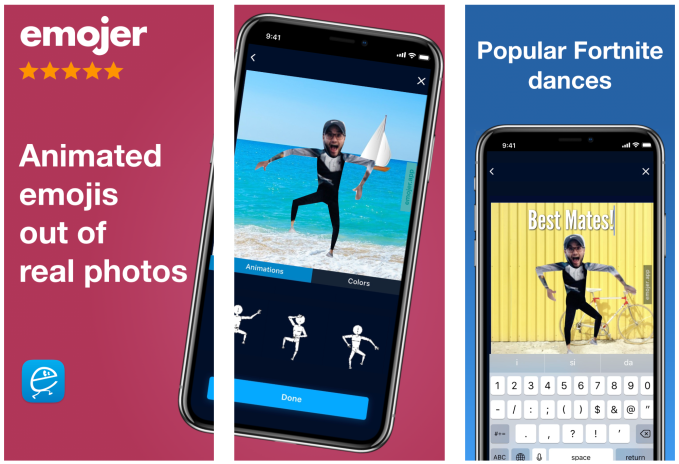
Creating animated emojis made from real photos, Emojer just might be the most fun you can have with a camera. The company’s software uses deep learning algorithms to detect body parts and guides users in creating their own avatars with just a simple photo take from a mobile phone. It’s replacing deep Photoshop expertise and animation skills with a super simple interface. The avatars look very similar to Elf Yourself, a popular site that let you paste your friends’ faces on dancing Christmas elves that went viral every year at Christmastime. Founders have PhDs in machine learning and computer vision.

Snark AI helps companies rent GPUs that aren’t in use. It’s one way to potentially reduce the cost of that GPU over time, which may be a substantial investment initially but could produce a meaningful return over time while it isn’t in use. How it works broadly: The startup matches the proper amount of GPU power to whatever a team needs, and then deploys it across a network of distributed idle cards that companies have in various data centers.
Snark’s approach can also ostensibly make “deep learning” run faster. In fact, its founders say the company is already working with five companies (which, okay, fine, could well be other startups in its cohort) to make their research cycles ten times faster.
Read more about Snark AI here.
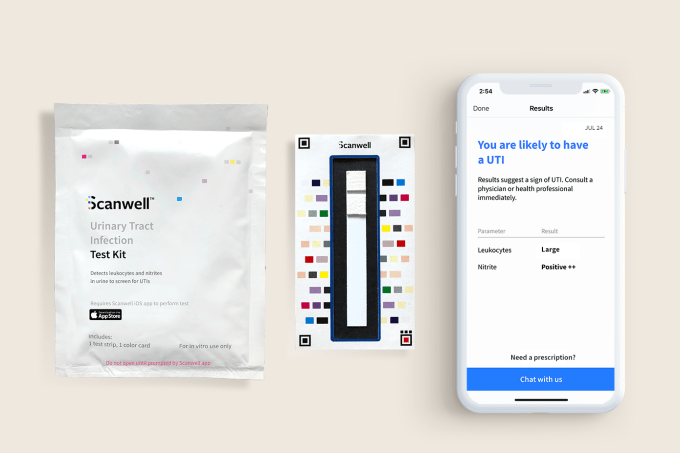
Urinary tract infections are highly uncomfortable and distracting and worse, often become more advanced, fast. It’s long been the case that treatment has required a doctor visit. But as of last month, a young San Francisco-based startup called Scanwell Health began selling directly to consumers the first time and, for now, remains the only FDA-cleared urine testing app that allows someone to test their urine at home using a paper test strip and a camera phone. (Its app uses sophisticated color metrics to analyze the strip and determine what’s what.)
Little wonder there’s some demand for the product. Company founder Stephen Chen said the company sold out of its kits – – 2,000 of them — as soon as they became available. Note the kits cost $5. A consultation to Scanwell to confirm the results — it relies on outside physicians — costs customers another $25
Read more about Scanwell Health here.

The scooter craze is hitting Latin America and Grin is greasing the wheels. The Mexico City-based company was launched by co-founder Sergio Romo after he and his partner realized they weren’t going to be able to get a cut of the big “birds” on the scooter block in the U.S. (as Axios reported). Romo and his co-founder have already lined up a slew of investors for what may be the hottest new deal in Latin America. Backers include Sinai Ventures, Liquid2 Ventures, 500 Startups, Monashees and Base10 Partners.

Mutiny helps business-to-business, software-as-a-service companies present a message that’s customized to each visitor on their website.
For example, when you visit the homepage of Mutiny customer Amplitude, things like the customer testimonials and the call to action will change depending on the size of your company. As for the size of the opportunity that Mutiny is chasing by helping its customers personalize theirsites? It claims it’s $5 billion.
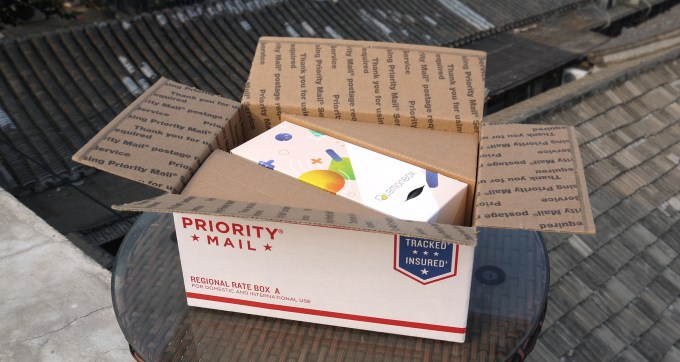
LemonBox is a startup that lets Chinese consumers buy U.S. health products at affordable prices. Today, it allows Chinese consumers to buy LemonBox-branded daily vitamin packs.
Further down the line, the goal is to expand into more specific verticals, including mother and baby, as well as beauty. It could even move beyond e-commerce with services like consultations with dietary experts.
Read more about LemonBox here.

Osh’s Affordable Pharmaceuticals is a public benefit corporation connecting doctors and patients with sources of low-cost, compounded pharmaceuticals. The company is looking to decrease barriers to entry for drugs for rare diseases. Three weeks ago the company introduced a drug to treat Wilson’s Disease. There was no access to the drug that treats the disease before in Brazil India or Canada. It slashes the cost of drugs from $30,000 a month to $120 per month. The company estimates it has a total addressable market of $17 billion. “Generic drug pricing is a crisis, people are dying because they can’t get access to the medicine they need,” says chief executive Alex Oshmyansky. Osh’s might have a solution.

Ubits is Lynda.com for Latin America. Ubits offers corporate training classes in Spanish for topics like leadership, sales and Microsoft Excel. Currently, there are no good options available in Spanish, the second most common language in the world. Ubits has 1000 videos on 80 online courses. They have 75 customers including Citi, Dow, Nestle, BNP Paribas, who pay on average $9K a year. They have $700K in ARR, growing 40 percent month over month.There are 40 million office workers in Latin America. They charge $50 per employee per year.
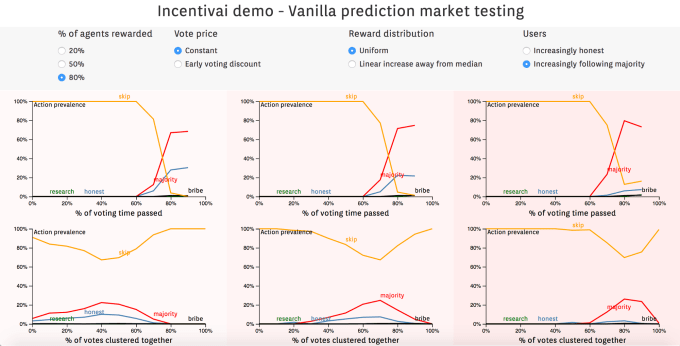
Cryptocurrency projects can crash and burn if developers don’t predict how humans will abuse their blockchains. Incentiveai has built artificial intelligence simulations that test not just for security holes, but for how greedy or illogical humans can crater a blockchain community.
Crypto developers can use the service to fix their systems before they go live. They can either pay Incentivai to audit their project and produce a report, or they can host the AI simulation tool like a software-as-a-service. Already, the company — founded just two months ago — says it’s seeing $250,000 in revenue from three paying customers, including market forecasting startup Augur, which is perhaps best known for orchestrating the first ICO on the ethereum network.
Read more about Incentiveai here.

Toybox is pitching a software service that lets designers communicate changes to developers on any website without ever having to write a line of code. The changes are noted as CSS edits for developers, so the quick fixes can be implemented easily. It reduces the need for communication between designers and developers over minor changes to images or visuals and can significantly speed up production, the company said. The company has picked a $180 price point per seat. They have 400 active users after launching four weeks ago.

Using a network of 7,000 tutors, Turkish test-prep app Kunduz is building a service that the company argues is ten times cheaper and faster than traditional tutoring options. Like its U.S. counterpart, Toot, Kunduz users take a picture of a problem using the app, and then it links the studen with a tutor. Students looking for help typically get an answer in 10 minutes, according to the company, which says that one-third of the questions asked are “repeat” questions and thus can be answered within seconds without the help of a human. Launched in Turkey first, Kunduz has already answered 3 million questions in its home market, where its addressable market is in the $2.4 billion range. Next up, it says, is India.

The current system for making meat is broken. The Good Food Institute, a non-profit promoting meat alternatives and clean meat, is operating as a think tank and accelerator for the plant-based and clean meat sector. It’s designing curriculum for colleges across the country. It currently has 350 entrepreneurs in its ecosystem. And it’s launching a conference around clean meat and plant-based meat. The organization is trying to boost portfolio growth in the plant-based substitute and clean-meat space, and it’s consulting with venture firms that are looking at investing in the industry.

Plus-size women have limited clothing options even at the largest retailers like Nordstrom and Macy’s. While a majority of American women fall into the plus-size clothing category, 100 million women are constrained to shopping for a very small percentage of options. And Comfort wants to solve the supply problem. To do this, the founders, two former Harvard classmates, are building a direct-to-consumer fashion brand with stylish, minimalist offerings for plus-size women, including tunic shirts and an apron dress. It’s very early days for the brand, but since launching in recent weeks, they’ve seen $25,000 in sales.

Doctors in emerging markets will have access to an artificially intelligent clinical assistant if the founders of Bot M.D. have their way. The company has developed a bot that can provide answers to questions about drugs, drug interactions and diseases, while also transcribing dictated case notes. For any doctor with a smartphone, Bot M.D. could be their downloadable, affordable, and scalable way to improve patient care in places where the help is sorely needed. The data it gleans from these interactions could prove lucrative, too. As the company notes, pharmaceutical companies shell out $3 billion a year to understand their doctor-customers. If it can be repository for them, it can potentially garner a percentage of that spend.

OKCredit helps small and mid-size businesses in India — the world’s largest base of SMBs — which extend $500 billion of credit to consumers every year…on paper. OKCredit digitizes their transactions and records payment, reducing the burden of these businesses that are currently maintaining and accounting paper account books.
It appears to have struck a chord. Already the company is working with 15,000 businesses, and it hasn’t spent any money on marketing it says. As for the need it’s addressing, it says it’s a $300 billion market.

No need to caveat this Emptor. Helping local companies find facilities and maintenance providers like janitors, landscapers and HVAC repair technicians, Emptor bills itself as a Thumbtack for the enterprise and includes a machine learning system that will classify spending and provide recommendations for cost reductions.
That kind of offering could be music to hospitals’ ears. Many hospitals lose money, and those that don’t see margins on average of just 2.6 percent, says the company. Things are poised to grow worse for them, too, owing to a regulation passed in 2015 that could reduce spending on hospital services by up to $250 billion by 2030, according to a study published last year in Health Affairs. If Emptor can give them a way to control their operating expenses and improve their margins, everyone wins.

Put simply, Dinesafe wants to ensure that outbreaks of food poisoning will be a thing of the past. Foodborne illnesses sicken 48 million people, and kill roughly 3,000 people in the U.S. alone each year. Through its website iwaspoisoned.com, the company allows for user-generated reports of food poisoning to detect outbreaks in real time. In fact, the company says it predicted that Chipotle would have food safety issues prior to its spate of outbreaks earlier this year.
The company has 25,000 consumer subscribers and offers data services, surveillance, benchmarking and industry analytics to corporate customers and 280 public health agencies. The service is helpful for restaurants, too. If they want to stay ahead of these trends, they need this data. No wonder 16 restaurant chains are already signed up for the service.

Providing payment fulfillment services for businesses that still use old line payment mechanisms like checks, wire transfers or automated clearing houses, Modern Treasury wants to save companies time and money. Acting as a Stripe for non-credit card transactions, the company offers a way for businesses to swap out the homegrown infrastructure and excel spreadsheets they were using to manage payments.
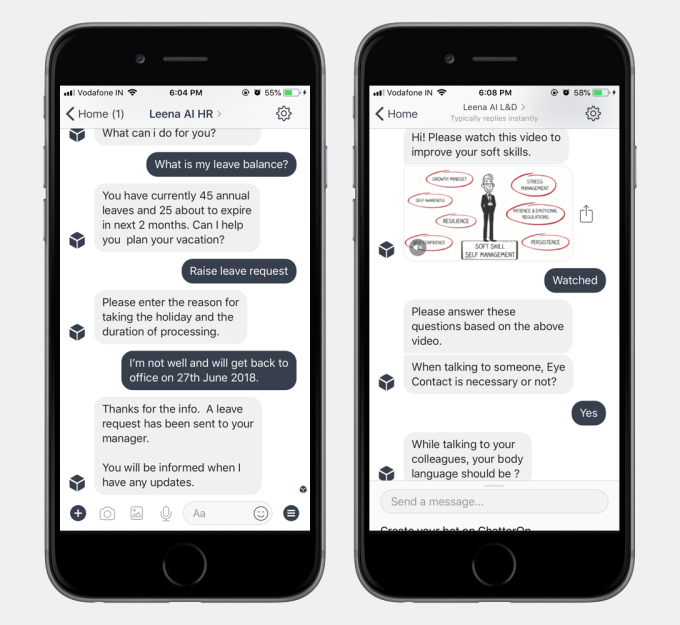
Leena AI is building HR bots to answer questions for employees instantly. The bots can be integrated into Slack or Workplace by Facebook, and they’re built and trained using information in policy documents and back-end systems.
Some of of the questions and answers are pretty standard, covering things like vacations and expense reports. But Leena AI also uses natural language processing to understand a company’s unique terminology or just the unusual ways someone might ask those questions.
Read more about Leena AI here.

Abacus Protocol allows any company to tokenize both fungible and non-fungible assets (like commodities, equities, or debt) and automate their compliance demands — like know your customer, SEC registration exemptions and securities restrictions. These functions happen not just at the time of issuance but also on every secondary transaction or transfer of the security token. Using the platform, companies can take advantage of the benefits of tokenizations, making assets more liquid and simplifying bookkeeping without needing to hire a dev team.
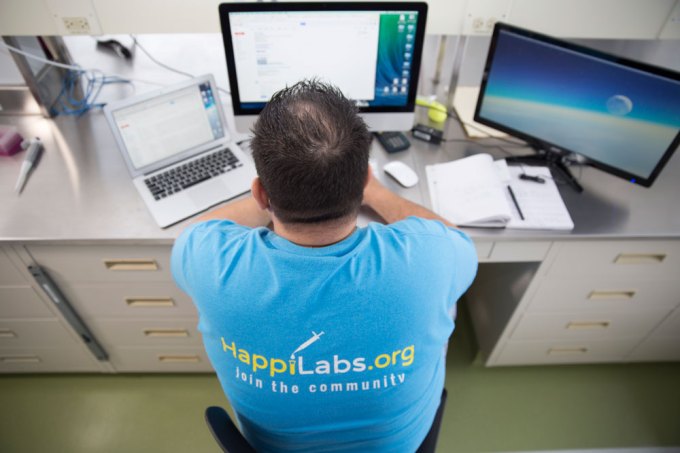
HappiLabs is a virtual lab manager, spanning topics from biotech and brain research to robotics. It’s already working with 26 labs across the country, helping them buy everything from beakers to gloves to specialized machines in a cost-effective way.
Founder and CEO Tom Rugins is a former Ph.D. student and lab manager himself, and he said he was taken aback at how far behind scientific purchasing was from the rest of the retail world.
Read more about HappiLabs here.
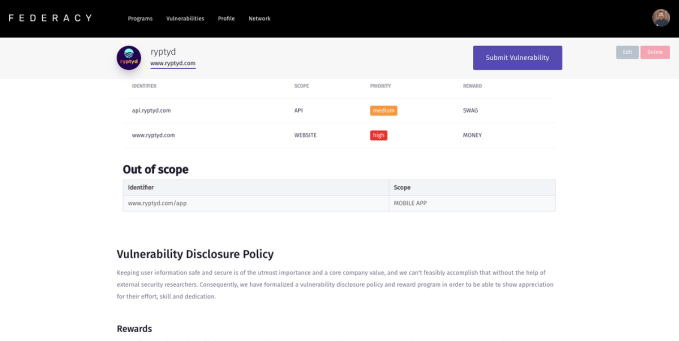
Federacy has a mission to make bug bounty programs available to even the smallest startup. The idea is to make it free and simple for startups to set up bug bounties.
For now, the co-founders are vetting every researcher they bring on the platform. While they realize this approach probably won’t be sustainable forever, they want to control access while they build out the platform.
Read more about Federacy here.

The youngs in Gen Z love to take quizzes and companies love selling to the youngs in Gen Z. Those two truths have the team behind College Pulse salivating about the opportunity they see for their business. Using the company’s service, students can poll their community to find out what’s going on around their campus. Queries range from finding the correlation between sexual activity and GPA, to what’s the most popular spot to get a malt around town. Already active on 33 college campuses around the country, the company is profitable from selling its access to a much-envied audience of open wallets. Founded on Dartmouth’s campus, the company sees a future in an ad-supported content delivery platform for folks who want to know.

Tackling a $765 billion problem of healthcare waste Medinas Health is giving hospitals an easy way to resell their used and surplus medical equipment and supplies. The company has already raised $1 million for its marketplace to help healthcare organizations buy and sell equipment. With a seed round led by Ashton Kutcher and Guy Oseary’s Sound Ventures, and General Catalyst’s Rough Draft Ventures fund, the company is also working to lower costs for cash-strapped rural health care centers.

OpenPhone has been working on an app to make it easier to get and use a business phone number. You don’t need a second phone, you don’t need to get an expensive solution designed for big teams.
After downloading the iOS or Android app, you can get a second phone number for $9.99 per month. It can be a local or a toll-free number in the U.S. or Canada. You can also port an existing phone number and get rid of your second phone.
Read more about OpenPhone here.

iLabService is a Chinese laboratory monitoring, management and automation service. They use sensors to monitor lab equipment and alert you when something is wrong. They are currently tracking 1500 pieces of equipment. There are 300,000 labs in China using 25 million pieces of equipment. They charge 200 million for the equipment per year, creating a $5 billion market opportunity in China. The founders spotted this massive unmet customer need while working at ThermoFisher.

The Splish app pops content into video loops of between 1-5 seconds. Photos can be uploaded too, but motion must be added in the form of an animated effect of your choice. So basically, nothing on Splish stays still.
While wobbly, content on Splish is intended to stick around, rather than ephemerally pass away (à la Snaps). The idea is that sharing stuff on Splish is a bonding experience; part of an ongoing smartphone-enabled conversation between mates, rather than a selectively manicured photoshoot. In fact, the startup has quickly zeroed in on teens, primarily because unlike adults who take vacation photos and capture dinner outings that they post to social media, teens “don’t have anything to do,” so it tells them what to post. (These “cues” can include suggestions like that users film themselves chugging hot sauce, for example.) Teens apparently like the idea. Launched six weeks ago, the company says the average user opens the app four times a day. It isn’t disclosing how many users it has attracted so far.

CowryWise wants to bring the benefits of algorithmically managed investment platforms to Africans across the continent. Taking a page from the Betterment and Wealthfront playbooks that have been popularized in the U.S., CowryWise enables young, high net-worth Africans to invest their money more intelligently — with the machine learning tools previously available only to large financial services institutions.

Radix Labs wants to be the operating system for laboratories. Organizing lab equipment in a networked fashion could have a dramatic impact on research and development. Today, lab equipment is like maniframes in the 80s, where each device needs to be programmed separately. Running experiments serially can reduce the time it takes to come up with results, letting biologists automate their labs and experimentation to mimic the mass production of manufacturing.
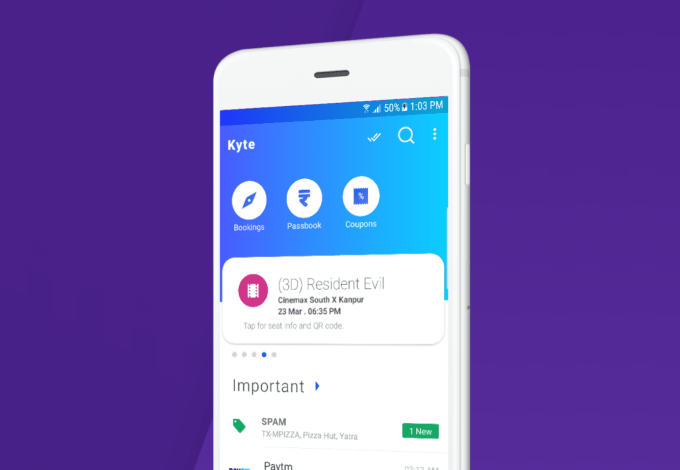
Last year, Indian businesses sent 180 billion SMS messages to customers, 60 percent of which was spam according to the team at Kyte. The company’s AI-powered SMS inbox looks to ditch the spam and organize transactions notes as well as coupons for Indian users into a cleanly designed hub. The inbox decluttering startup is growing 13 percent week over week as it looks to capture the 300 million smartphone users in India.

Image credit: Li-Anne Dias, Crunchbase News.
Hypcloud is building a real estate development financing platform in Germany. The team is hoping to distinguish what they’ve built by enabling more collaborative and efficient negotiation times through a more streamlined workflow that will hopefully give customers quicker access to financing partners. Using the web-based software, clients can negotiate with up to 5 banks at the same time to get better terms.

Miru built an AR app that shows users what any piece of furniture will look like in their home. The Miru app places items in your living space using a computer vision pipeline that lets you pull items from any retailers website. Ikea has similar services, but only for their own catalogue of products. Furniture visualization is a 6.5 billion market, but that’s just the beginning. While using Miru’s visualization service, the app can map your home and gather data for future home projects like painting and flooring.

Klarity wants to automate parts of the contract review process by applying artificial intelligence, specifically natural language processing. It offers a subscription cloud service that checks contracts in Microsoft Word documents, making suggestions when it sees something that doesn’t match up with the playbook checklist.
The product then generates a document, and a human lawyer reviews and signs off on the suggested changes, reducing the review time from an hour-plus to 10 or 15 minutes.

The founding team from precision medicine startup Simpatica Medicine is back with SF17 Therapeutics, a precision medicine analytics platform providing monitoring for pediatric rheumatologists for life-threatening conditions. The technology enables pediatricians to match patients with the right treatment regimen or regimen changes if a course of treatment isn’t working. That same platform is also being used to demonstrate drug discovery capabilities that can identify targets for new drug compound development.
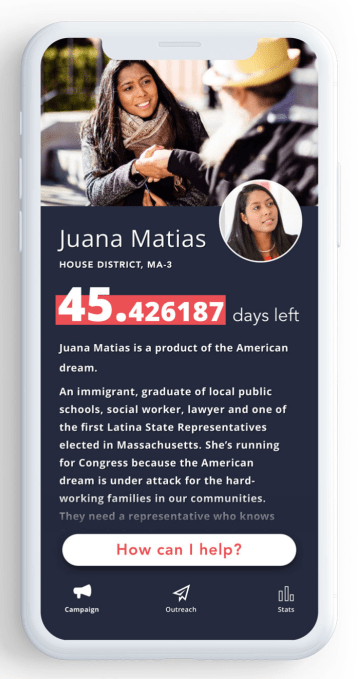
Outvote wants to make grassroots-style campaigning easier and more personal, with the launch of an app that allows people to text their friends with reminders to vote.
While today there are a lot of tools for voter outreach, many of those operated by well-known organizations like MoveOn involve people opting in to receive texts from the group in question. Outvote is different because it’s a tool that helps individual voters reach out to their own personal acquaintances, family and friends. The idea, says its founder, is to learn which of one’s friends and associates are not voting, then pressure them to get to the polls.
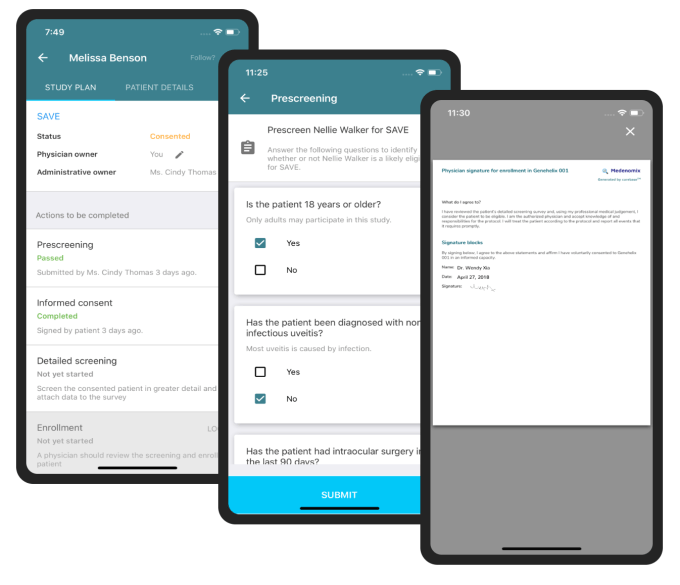
Curebase is aiming to run clinical trials faster and cheaper than anyone else via software that reduces recruitment times, automates manual steps, and lets drug companies distribute their trials to clinics. Considering that clinical trials are logistical nightmares, often coordinated across dozens of locations, any solution sounds like an improvement, and Curebase’s “clinical trial marketplace” says that already, three deals are expected to generate $175,000 in revenue that should help it convince more customers of the merits of its software and full-service support.
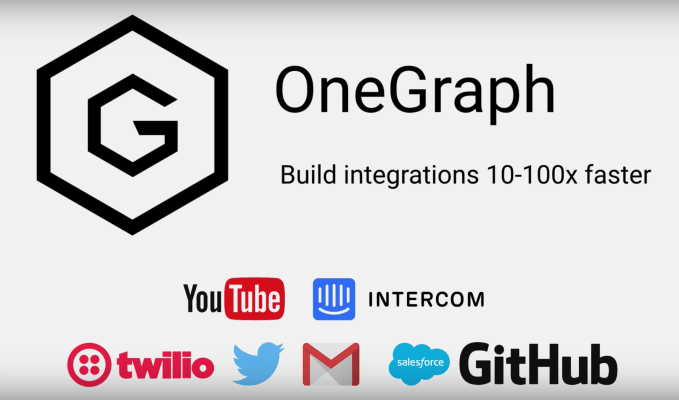
OneGraph is a GraphQL service that aims to connect the world wide web’s SaaS APIs and help customers build integrations way quicker than is currently possible. OneGraph has support for than a couple dozen APIs including Stripe, Salesforce, GitHub and more.

DreamCraft is a platform that lets video game modders create and monetize games without writing code. The company says game modding is a $4 billion industry, but that modders generally don’t make any money because they simply don’t own the original games. On DreamCraft, modders will be able to create new games, while keeping 70% of the revenue and gaining the freedom to host these titles. The co-founders hail from Google and EA, and want to build the platform that will act as the app store for game modders.

Using the Lightning Network to perform trustless, peer-to-peer swaps, SparkSwap is looking to build a new way to trade cryptocurrency pairs like Bitcoin and Litecoin without depositing assets on an exchange.

ExceptionAlly aims to help parents understand, organize and communicate all the info around providing care and education for a child with special needs, from autism to Down Syndrome.
The first step is education: Based on information provided by the parent, the startup’s platform assists the parent in understanding both the condition itself, what they can expect from a school, and what their rights are (like whether their kid merits a front-row seat or how often teachers are sharing reports on a child’s progress). It can also help parents collaborate with schools and teachers to create individual education plans.
Beyond education planning, ExceptionAlly has plans to replace the costly financial and healthcare planning experts who often cost these same parents upwards of $10,000 a year. How big a business the startup can create is an open question, but we love the idea of parents no longer needing a lawyer or other pricey professional to negotiate on their behalf of their child.
Read more about ExceptionAlly here.
Congratulations if you’ve made it this far, you’re pretty informed on the latest batch. Stay tuned a bit later for a rundown of our favorites from today’s group of startups.
Powered by WPeMatico
Facebook has been a bit slow to adopt the voice computing revolution. It has no voice assistant, its smart speaker is still in development, and some apps like Instagram aren’t fully equipped for audio communication. But much of that is set to change judging by experiments discovered in Facebook’s code, plus new patent filings.
Developing voice functionality could give people more ways to use Facebook in their home or on the go. Its forthcoming Portal smart speaker is reportedly designed for easy video chatting with distant family, including seniors and kids that might have trouble with phones. Improved transcription and speech-to-text-to-speech features could connect Messenger users across input mediums and keep them on the chat app rather than straying back to SMS.
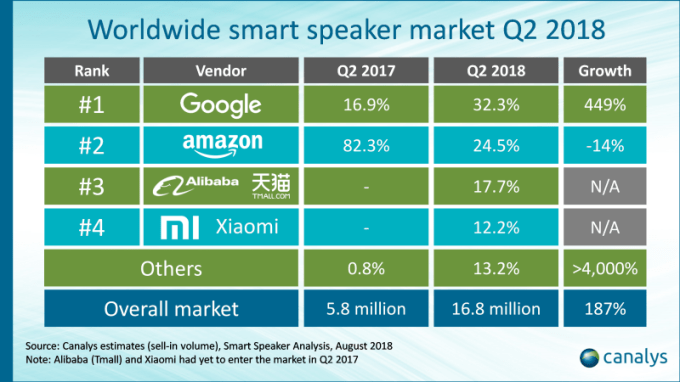
But Facebook’s voice could be drowned out by the din of the crowd if it doesn’t get moving soon. All the major mobile hardware and operating system makers now have their own voice assistants like Siri, Alexa, Google Assistant and Samsung Bixby, as well as their own smart speakers. In Q2 2018, Canalys estimates that Google shipped 5.4 million Homes, and Amazon shipped 4.1 million Echoes. Apple’s HomePod is off to a slow start with less than 6 percent of the market, behind Alibaba’s smart speaker, according to Strategy Analytics. Facebook’s spotty record around privacy might deflect potential customers to its competitors.
Given Facebook is late to the game, it will need to arrive with powerful utility that solves real problems. Here’s a look at Facebook’s newest developments in the voice space, and how its past experiments lay the groundwork for its next big push.
Facebook is developing its own speech recognition feature under the name Aloha for both the Facebook and Messenger apps, as well as external hardware — likely the video chat smart speaker it’s developing. Code inside the Facebook and Messenger Android apps dug up by frequent TechCrunch tipster and mobile researcher Jane Manchun Wong gives the first look at a prototype for the Aloha user interface.
Labeled “Aloha Voice Testing,” as a user speaks while in a message thread, a horizontal blue bar expands and contracts to visualize the volume of speech while recognizing and transcribing into text. The code describes the feature as having connections with external Wi-Fi or Bluetooth devices. It’s possible that the software will run on both Facebook’s hardware and software, similar to Google Assistant that runs both on phones and Google Home speakers. [Update: As seen below, the Aloha feature contains a “Your mobile device is now connected Portal” screen, confirming that name for the Facebook video chat smart speaker device.]
Facebook declined to comment on the video, with its spokesperson Ha Thai telling me, “We test stuff all the time — nothing to share today but my team will be in touch in a few weeks about hardware news coming from the AR/VR org.” It unclear if that hardware news will focus on voice and Aloha or Portal, or if it’s merely related to Facebook’s Oculus Connect 5 conference on September 25th.
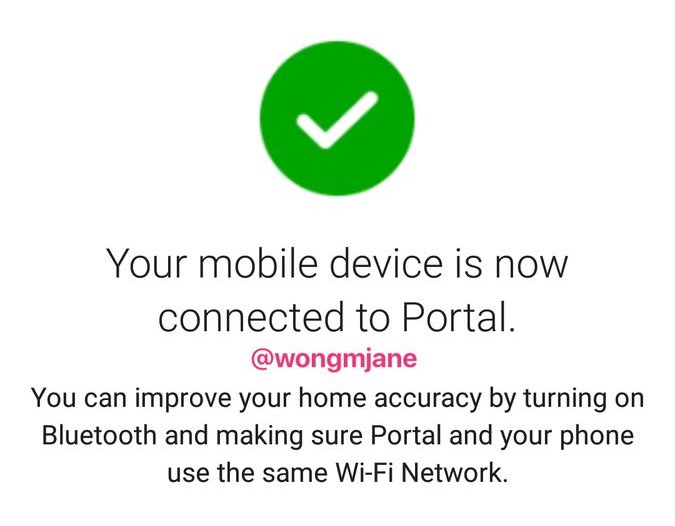
A source previously told me that years ago, Facebook was interested in developing its own speech recognition software designed specifically to accurately transcribe how friends talk to each other. These speech patterns are often more casual, colloquial, rapid and full of slang than the way we formally address computerized assistants like Amazon Alexa or Google Home.
 Wong also found the Aloha logo buried in Facebook’s code, which features volcano imagery. I can confirm that I’ve seen a Facebook Aloha Setup chatbot with a similar logo on the phones of Facebook employees.
Wong also found the Aloha logo buried in Facebook’s code, which features volcano imagery. I can confirm that I’ve seen a Facebook Aloha Setup chatbot with a similar logo on the phones of Facebook employees.
If Facebook can figure this out, it could offer its own transcription features in Messenger and elsewhere on the site so users could communicate across mediums. It could potentially let you dictate comments or messages to friends while you have your hands full or can’t look at your screen. The recipient could then read the text instead of having to listen to it like a voice message. The feature also could be used to power voice navigation of Facebook’s apps for better hands-free usage.

Facebook awarded patent for speaker
Facebook’s video chat smart speaker was reportedly codenamed Aloha originally but later renamed Portal, Alex Heath of Business Insider and now Cheddar first reported in August 2017. The $499 competitor to the Amazon Echo Show was initially set to launch at Facebook’s F8 in May, but Bloomberg reported it was pushed back amid concerns that it would exacerbate the privacy scandal ignited by Cambridge Analytica.
A new patent filing reveals Facebook was considering building a smart speaker as early as December 26th, 2016 when it filed a patent for a cube-shaped device. The patent diagrams an “ornamental design for a speaker device” invented by Baback Elmieh, Alexandre Jais and John Proksch-Whaley. Facebook had acquired Elmieh’s startup Nascent Objects in September of that year and he’s now a technical project lead at Facebook’s secretive Building 8 hardware lab.
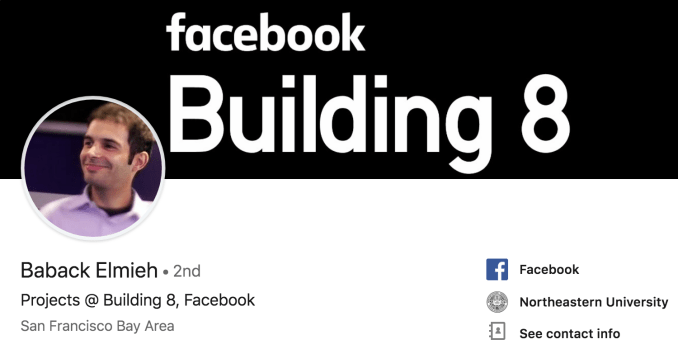
The startup had been building modular hardware, and earlier this year he was awarded patents for work at Facebook on several modular cameras. The speaker and camera technology Facebook has been developing could potentially evolve into what’s in its video chat speaker.
The fact that Facebook has been exploring speaker technology for so long and that the lead on these patents is still running a secret project in Building 8 strengthens the case that Facebook has big plans for the voice space.

Patents awarded to Facebook show designs for a camera (left) and video camera (right)
And finally, Instagram is getting deeper into the voice game, too. A screenshot generated from the code of Instagram’s Android app by Wong reveals the development of a voice clip messaging feature heading to Instagram Direct. This would allow you to speak into Instagram and send the audio clips similar to a walkie-talkie, or the voice messaging feature Facebook Messenger added back in 2013.
You can see the voice button in the message composer at the bottom of the screen, and the code explains that to “Voice message, press and hold to record.” The prototype follows the recent launch of video chat in Instagram Direct, another feature on which TechCrunch broke the news thanks to Wong’s research. An Instagram spokesperson declined to comment, as is typical when features are spotted in its code but aren’t publicly testing yet, saying, “Unfortunately nothing more to share on this right now.”

 Facebook has long tinkered in the voice space. In 2015, it acquired natural language processing startup Wit.ai that ran a developer platform for building speech interfaces, though it later rolled Wit.ai into Messenger’s platform team to focus on chatbots. Facebook also began testing automatically transcribing Messenger voice clips into text in 2015 in what was likely the groundwork for the Aloha feature seen above. The company also revealed its M personal assistant that could accomplish tasks for users, but it was only rolled out to a very limited user base and later turned off.
Facebook has long tinkered in the voice space. In 2015, it acquired natural language processing startup Wit.ai that ran a developer platform for building speech interfaces, though it later rolled Wit.ai into Messenger’s platform team to focus on chatbots. Facebook also began testing automatically transcribing Messenger voice clips into text in 2015 in what was likely the groundwork for the Aloha feature seen above. The company also revealed its M personal assistant that could accomplish tasks for users, but it was only rolled out to a very limited user base and later turned off.
The next year, Facebook’s head of Messenger David Marcus claimed at TechCrunch Disrupt that voice “is not something we’re actively working on right now,” but added that “at some point it’s pretty obvious that as we develop more and more capabilities and interactions inside of Messenger, we’ll start working on voice exchanges and interfaces.” However, a source had told me Facebook’s secretive Language Technology Group was already exploring voice opportunities. Facebook also began testing its Live Audio feature for users who want to just broadcast sound and not video.
By 2017, Facebook was offering automatic captioning for Pages’ videos, and was developing a voice search feature. And this year, Facebook began trying voice clips as status updates and Stories for users around the world who might have trouble typing in their native tongue. But executives haven’t spoken much about the voice initiatives.
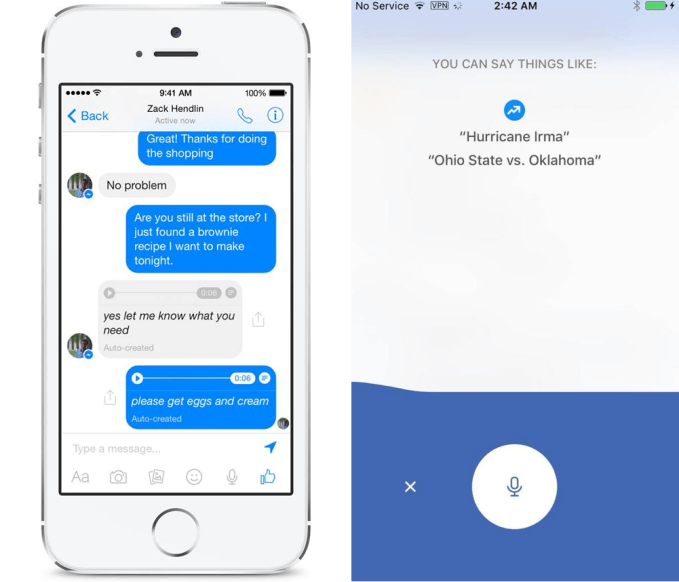
The most detailed comments we have come from Facebook’s head of design Luke Woods at TechCrunch Disrupt 2017 where he described voice search saying it was, “very promising. There are lots of exciting things happening…. I love to be able to talk to the car to navigate to a particular place. That’s one of many potential use cases.” It’s also one that voice transcription could aid.
It’s still unclear exactly what Facebook’s Aloha will become. It could be a de facto operating system or voice interface and transcription feature for Facebook’s smart speaker and apps. It could become a more full-fledged voice assistant like M, but with audio. Or perhaps it could become Facebook’s bridge to other voice ecosystems, serving as Facebook’s Alexa Skill or Google Assistant Action.
When I asked Woods “How would Facebook on Alexa work?,” he said with a smile “That’s a very interesting question! No comment.”
Powered by WPeMatico
A new way to attack Facebook is to fraudulently report a news story as false in hopes of reducing its visibility, either because someone wants to censor it or just doesn’t agree with it. Sometimes known as “brigading,” a concerted effort by trolls to flag a piece of content can reduce its visibility. Facebook now sends stories reported as false to third-party fact checkers, and these purposefully inaccurate reports can clog the already-overcrowded queues that fact checkers struggle to worth through.
That’s why Facebook gives users a trustworthiness score ranging from 0 to 1 depend on the reliability of their flags of false news, The Washington Post reports. If they flag something as false news but fact checkers verify it as true, that could hurt their score and reduce how heavily Facebook factors in their future flagging. If users consistently report false news that’s indeed proven to be false, their score improves and Facebook will trust their future flagging more.

Facebook’s News Feed product manager Tessa Lyons confirmed the scoring system exists. There’s currently no way to see your own or someone else’s trustworthiness score. And other signals are used to compute the score as well, though Facebook won’t reveal them for fear of trolls gaming the system.
This isn’t the only way Facebook ranks users, though. It assigns you a shifting score of affinity toward each of your friends that determines how frequently you see them in the News Feed. This “friend-ranking” score is essentially a measure of graph distance from you to someone else.

If you like a ton of someone’s posts, get tagged in photos with them, search for them, view their profile, communicate with them, have lots of mutual friends, are in the same Groups and have similar biographical characteristics like location and age, your score toward them is lower and you’ll see more of them in your feed. However, they have a different score for you depending on their behavior, so constantly viewing someone else’s profile won’t make you show up in their feed more if they don’t reciprocate the interest.
I first reported on these friend scores almost exactly seven years ago, and you can still view them for yourself using this browser bookmarklet built by Jeremy Keeshin. Visit this site, drag the “Facebook Friends Rankings” link into your desktop browser’s bookmark bar, open Facebook while logged in, and tap the bookmarklet to reveal the Friend Ranking scores of your friends. It snoops the Facebook JavaScript to pull out the scores. The people you see at the top are who you’re closest to.
The need for this score highlights the difficulties of Facebook’s battle against fake news. Between subjectivity and purposeful trolling, there’s a lot of noise coming in with the signal about what should be removed. Anyone saying Facebook should have easily solved the fake news problems is likely underappreciating the nuance required and the intelligent human adversaries Facebook must defeat.
Facebook has a huge array of signals it can use to calculate Friend Rankings or trustworthiness scores. The question will be whether it can intelligently sort those signals to make coherent inferences about what to show us and when to believe us.
Powered by WPeMatico
Talla is taking aim at the customer service industry with its latest release, an AI-infused knowledge base. Today, the company released version 2.0 of the Talla Intelligent Knowledge Base.
The company also announced that Paula Long, most recently CEO at Data Gravity, has joined the company as SVP of engineering.
This tool combines customer content with automation, chatbots and machine learning. It’s designed to help teams who work directly with customers get at the information they need faster and the machine learning element should allow it to improve over time.
You can deploy the product as a widget on your website to give customers direct access to the information, but Rob May, company founder and CEO says the most common use case involves helping sales, customer service and customer success teams get access to the most relevant and current information, whether that’s maintenance or pricing.
The information can get into the knowledge base in several ways. First of all you can enter elements like product pages and FAQs directly in the Talla product as with any knowledge base. Secondly if an employee asks a question and there isn’t an adequate answer, it exposes the gaps in information.
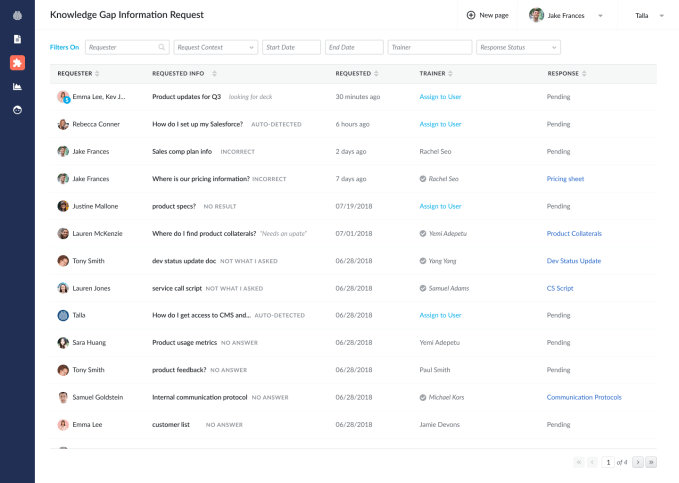
Talla Knowledge Base gap list. Screenshot: Talla
“It really shows you the unknown unknowns in your business. What are the questions people are asking that you didn’t realize you don’t have content for or you don’t have answers for. And so that allows you to write new content and better content,” May explained.
Finally, the company can import information into the knowledge base from Salesforce, ServiceNow, Jira or wherever it happens to live, and that can be added to a new page or incorporated into existing page as appropriate.
Employees interact with the system by asking a bot questions and it supplies the answers if one exists. It works with Slack, Microsoft Teams or Talla Chat.
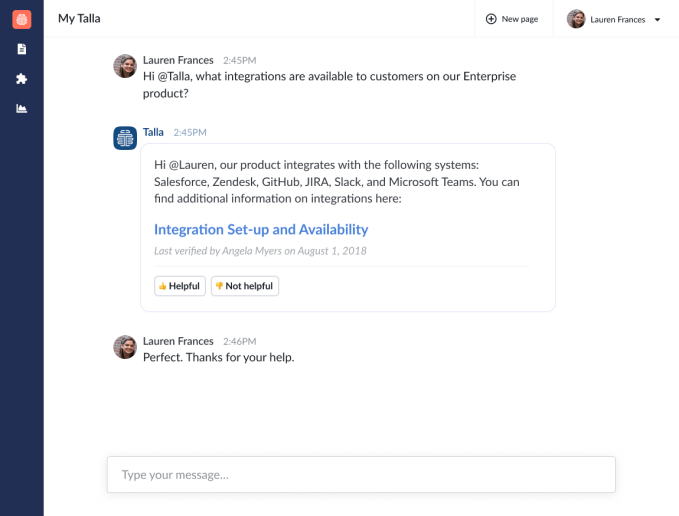
Talla bot in action in Talla Chat. Screenshot: Talla
Customer service remains a major pain point for many companies. It is the direct link to customers when they are having issues. A single bad experience can taint a person’s view of a brand, and chances are when a customer is unhappy they let their friends know on social media, making an isolated incident much bigger. Having quicker access to more accurate information could help limit negative experiences.
Today’s announcement builds on an earlier version of the product that took aim at IT help desks. Talla found customers kept asking for a solution that provided similar functionality with customer-facing information and they have tuned it for that.
May launched Talla in 2015 after selling his former startup Backupify to Datto in 2014. The company, which is based near Boston, has raised $12.3 million.
Powered by WPeMatico
Tinder is today rolling out what may be one of its smartest additions yet with the launch of Tinder U, a feature designed specifically for Tinder users in college. Once enabled, students with a .edu email address will be able to register with their school, then swipe on students who also attend their school or others nearby. Beyond limiting potential matches to other students, the overall Tinder experience is unchanged.
Students will still be able to view each others’ profiles, swipe right and left to match or pass, message mutual matches, use Super Likes, and more.
To use Tinder U, students will first have to be geolocated on campus and log in to the Tinder app using their .edu email address. They’ll then have to check their inbox for the verification email and tap the button to confirm their account.
After completing this process, users will be in the Tinder U experience the next time they launch the app.
Here, students will see their school’s logo appear at the top of the screen, and individual profile photos will have flair on the bottom left to indicate the user’s school. Tinder U doesn’t prevent users from swiping off campus, however – using a toggle button at the top of the screen (see photo above), users can choose to swipe by location instead, or by Tinder Picks by toggling over to the diamond icon, if they’re a Gold member.
Tinder U makes sense for the company, whose user base already skews younger – it has said before that half its user base is between 18 and 24, for example. And dating apps’ usage, in general, among this age group has roughly tripped from 10% in 2013 to 27% by 2016, according to Pew Research. And of course, there’s the fact that Tinder itself got its start on college campuses – a market that’s young, single, and more willing to adopt mobile dating apps than other, older demographics.
The feature arrives at a time when Facebook is poised to enter the dating market – a market Tinder and its parent company Match Group today dominate. Tinder now has an estimated 50 million worldwide users, and nearly 3.8 million subscribers.
“Five years ago at college campuses around the U.S, students first heard about Tinder through friends. Tinder spread like wildfire, because it was a really fun and easy way to meet people who went to school, but you didn’t know personally,” Match Group CEO Mandy Ginsberg recently said, when announcing the product. “We believe it is critical that Tinder maintains a strong foothold at universities around the globe, especially given that every 18-year-old who starts college is building a social life from scratch making new friends and starting new relationships.”
Tinder says the new feature is launching initially on iOS devices at 4-year, accredited, not-for-profit schools in the U.S. that deliver courses in a traditional face-to-face learning format – meaning, no online universities or virtual schools will be supported. The company didn’t provide a timeframe for the Android release.
Powered by WPeMatico
IoT devices currently lack a standard way of applying security. It leaves consumers, whether business or individuals, left to wonder if their devices are secure and up-to-date. Foundries.io, a company that launched today, wants to change that by offering a standard way to secure devices and deliver updates over the air.
“Our mission is solving the problem of IoT and embedded space where there is no standardized core platform like Android for phones,” Foundries.io CEO George Grey explained.
What Foundries has created is an open and secure solution that saves everyone from creating their own and reinventing the wheel every time. Grey says Foundries’ approach is not only secure, it provides a long-term solution to the device update problem by providing a way to deliver updates over the air in an automated manner on any device from tiny sensors to smart thermostats to autonomous cars.
He says this approach will allow manufacturers to apply security patches in a similar way that Apple applies regular updates to iOS. “Manufacturers can continuously make sure their devices can be updated with the latest software to fix security flaws or Zero Day flaws,” he said.
The company offers two solutions, depending on the size and complexity of your device. The Zephyr RTOS microPlatform is designed for smaller, less complex devices. For those that are more complex, Foundries offers a version of Linux called the Linux OE microPlatform.
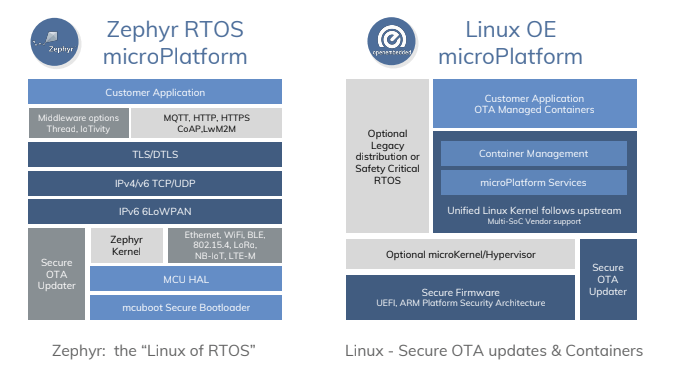
Diagram: Foundries.io
Grey claims that these platforms free manufacturers to build secure devices without having to hire a team of security experts. But he says the real beauty of the product is that the more people who use it, the more secure it will get, as more and more test it against their products in a virtuous cycle.
You may be wondering how they can make money in this model, but they do it by charging a flat fee of $10,000 per year for Zephyr RTOS and $25,000 per year for Linux OE. These are one-time prices and apply by the product, regardless of how many units get sold and there is no lock-in, according to Grey. Companies are free to back out any time. “If you want to stop subscribing you take over maintenance and you still have access to everything up to the point,. You just have to arrange maintenance yourself,” he said.
There is also a hobbyist and education package for $10 a month.
The company spun off from research at Linaro, an organization that promotes development on top of ARM chips.
To be successful, Foundries.io needs to build a broad community of manufacturers. Today’s launch is the first step in that journey. If it eventually takes off, it has the potential to provide a consistent way of securing and updating IoT devices, a move which would certainly be welcome.
Powered by WPeMatico
Google Fit is getting a major update today. The company’s activity tracking app has been around for a few years now but until today, it pretty much worked and looked that same as on the day it launched. Today’s redesign is quite a departure from that old look and feel, though, and it also introduces quite a few new features that help take the service in a new direction.
 The most obvious new feature in the new version is that instead of only focusing on active minutes (or ‘Move Minutes’ as they are called now), Google has now introduced the concept of Heart Points. With this, you don’t just score points for moving, the app will also reward you for activities that actually get your heart beating a bit faster. Google Fit will give you one point for every minute of moderate activity and double points for more intense activities (think running or kickboxing). You won’t be able to buy anything with those points, but you’re more likely to live longer, so there’s that.
The most obvious new feature in the new version is that instead of only focusing on active minutes (or ‘Move Minutes’ as they are called now), Google has now introduced the concept of Heart Points. With this, you don’t just score points for moving, the app will also reward you for activities that actually get your heart beating a bit faster. Google Fit will give you one point for every minute of moderate activity and double points for more intense activities (think running or kickboxing). You won’t be able to buy anything with those points, but you’re more likely to live longer, so there’s that.
Like before, Google Fit will automatically track your activities thanks to the sensors in your phone or Wear OS watch. You can always manually add activities, too, or use apps like Strava, Runkeeper, Endomondo and MyFitnessPal to get credit for the workouts you track with them.
What’s also new in this update is actionable coaching, something that was sorely missing from the old version. It remains to be seen how useful this new feature is in day-to-day use, but the idea here is to give you feedback on how active you’ve been throughout the week and help you stay motivated.
What I’m actually the most excited about, though, is the new look and feel. Based on the screenshots Google has shared so far, the app now provides you with far more details at a glance, without having to dig into timelines (which weren’t all that usable in the old version to begin with).
The new version is now rolling out to Android and Wear OS users.

Powered by WPeMatico
Semmle, a startup that originally spun out of research at Oxford, announced a $21 million Series B investment today led by Accel Partners. It marked the second time Accel has led an investment in the company.
Work-Bench also participated in the round. Today’s investment brings the total to $31 million.
Semmle has warranted this kind of interest by taking a unique approach to finding vulnerabilities in code. “The key idea behind our technology is to treat code as data and treat analysis problems as simple queries against a database. What this allows you to do is very easily encode domain expertise, security expertise or any other kinds of specialist knowledge in such a way it can be easily and automatically applied to large amounts of code,” Pavel Avgustinov, Semmle co-founder and VP of platform engineering told TechCrunch.
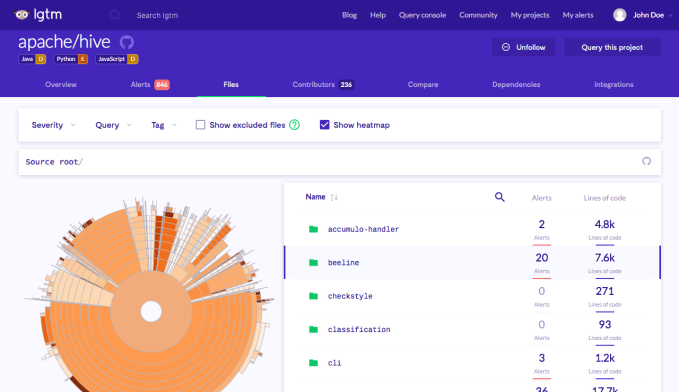
Screenshot: Semmle
Once you create the right query, you can continuously run it against your code to prevent the same mistakes from entering the code base on subsequent builds. The key here is building the queries and the company has a couple of ways to deal with that.
They can work with customers to help them create queries, although in the long run that is not a sustainable way of working. Instead, they share queries, and encourage customers to share them with the community.
“What we find is that the great tech companies we work with have the best security teams in the world, and they are giving back what they created on the Semmle platform with other users in an open source fashion. There is a GitHub repository where we publish queries, but Microsoft and Google are doing the same thing,” Oege de Moor, company CEO and co-founder explained.
In fact, the Semmle solution is freely available to open source programmers to use with their applications, and the company currently analyzes every commit of almost 80,000 open source projects. Open source developers can run shared queries against their code or create their own.
They also have a paid version with customers like Microsoft, Google, Credit Suisse, NASA and Nasdaq. They have relied mostly on these strategic partners up until now. With today’s investment they plan to build out their sales and marketing departments to expand their customer base into a wider enterprise market.
The company spun out of research at Oxford University in 2006. They are now based in San Francisco with 60 employees, a number that should go up with this investment. They received an $8 million Series A in 2014 and $2 million seed round in 2011.
Powered by WPeMatico